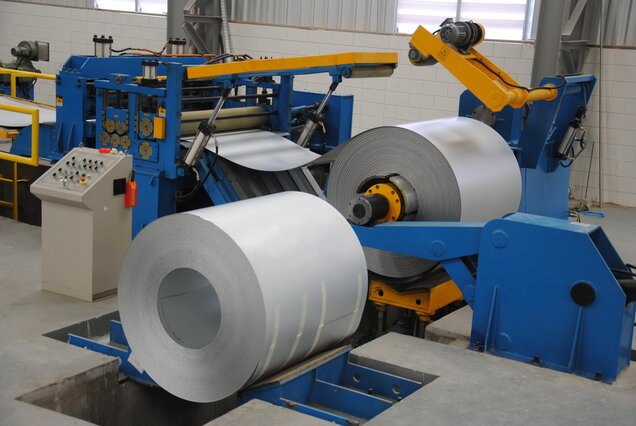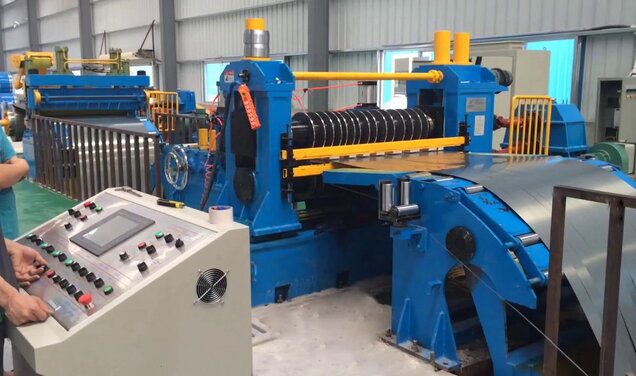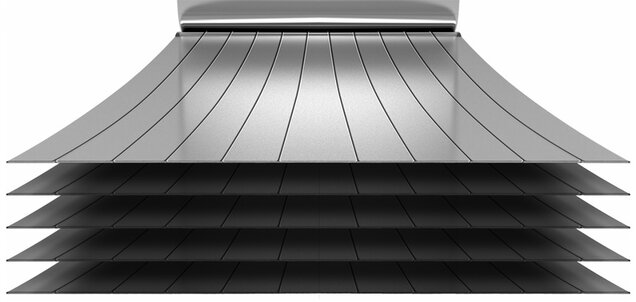Steel Slitting Lines
Metal sheets or strips suppliers always need slitting machine and cut to length machine line for the production of metal sheets with different widths or lengths from GI (galvanised iron), PPGI - PPGL (pre-painted galvanised iron), PCI (pre-coated steel) or stainless coils in large quantities.
A steel mill most of time produces only wide steel coils, and steel or metal fabricators always use a slitting and cut to length machine line to manufacture steel strips with different widths or metal sheets with fixed lengths. A metal slitting machine line has been designed to cut longitudinally the wide steel coils into different narrow steel strips for continuously producing cold formed sectional steel products.
Basically there are two types: high-speed and normal-speed slitting machine line. A High-speed slitter can works at max speed over 150 m/minute and over 10 strips can be produced; while a normal-speed slitting machine can work at most 40m/min with less than 10 strips slit.
Sheet metal coil slitting lines production.
Everything from highway rails, to HVAC components, to automotive components and possibly some of our kitchen appliances were produced using sheet metal coil slitting lines, cut to length lines, or punch press lines.

Líneas de corte longitudinal
Proporcionamos líneas de corte en tiras, capaces de satisfacer las necesidades de diferentes tipos de clientes
Líneas de altas prestaciones y gran flexibilidad para bobinas de hasta 45 ton y velocidad de trabajo de hasta 400 m/min, adecuadas para acerías, centros de servicio, sector automotor y muchos más. Líneas compactas y más sencillas, muy flexibles, para los casos en que se requiere una menor capacidad de producción.
Nuestras líneas de corte en tiras son adecuadas para trabajar materiales con anchuras de hasta 2200 mm y espesores variables de 0,2 a 20 mm, y se distinguen por la precisión y la calidad del producto final.
Nuestra gama de producción incluye:
- líneas de corte en tiras para espesores finos
- líneas de corte en tiras para espesores medios
- líneas de corte en tiras para espesores altos
- líneas de embalaje de cintas
Nuestras líneas de corte en tiras pueden trabajar diferentes materiales, tales como:
- acero laminado en frío o en caliente
- acero galvanizado, prepintado
- acero de alta resistencia
- acero inoxidable
- aluminio
- cobre
- zinc
- aleaciones
Prestamos mucha atención a la funcionalidad y la practicidad de los equipamientos, a fin de reducir al mínimo los tiempos de preparación de la línea.
Según el tipo de línea de corte longitudinal, podemos proponer:
- carga automática de la bobina
- cizallado automático de cabezal de bobina
- cambio de cabezal de la cizalla de cuchillas circulares – shuttle system – automático
- cambio automático de cuchillas, con torreta
- formación de paquetes de cuchillas automático robotizado
- bloqueo automático de las cuchillas
- sistema de bobinado de residuos, enrollador de residuos o cortador de residuos
- sistema con carro móvil de frenado
- frenado de las cintas con sistemas diferenciados según el tipo y la superficie del material
- cambio rápido de los grupos de separadores de cintas y fieltros
- grupos de separadores de cintas robotizados
- corte automático de las colas de las cintas
- pinzas móviles para acompañar automáticamente el cabezal de las cintas en la mordaza del carrete bobinador
- descarga automática de la bobina
- sistemas de flejado integrados
Todas nuestras líneas de corte en tiras están equipadas con softwares desarrollados en nuestro departamento técnico. Estos permiten la comunicación con los programas de gestión del cliente, la interconexión con sistemas automáticos de cambio de herramientas y con la línea de embalaje de cintas, si está presente. Además, cuenta con teleasistencia para el control de la línea y el mantenimiento a distancia.
Slitting line for metal coils
Slitting line for coils, metal coils. For widths of up to 2200 mm, thicknesses of up to 18 mm and speeds of up to 400 m/min. The lines are composed of high-precision slitters with quick tooling change for slitter, tensioning device and recoiler. Lines are offered with scrap ballers or scrap choppers. Moving tensioning devices with incorporated levelling. Lines are suitable to process materials used in the automotive and appliance industry, such as stainless steel, pre-painted, cold rolled steel, hot rolled carbon steel, electric steel, copper, brass and titanium.
Pressmach covers 3 Ranges of slitting lines
THIN GAUGE SLITTING LINE
Lines dedicated to small thicknesses at high speed.
TECHNICAL DATA
| Coils | 10 ÷ 30 Tons |
| Thickness | 0.2 ÷ 4 mm |
| Width | 200 ÷ 2200 mm |
| Speed | 200 ÷ 500 m/min |
MEDIUM GAUGE SLITTING LINES
Slitting Lines for high production.
TECHNICAL DATA
| Coils | 15 ÷ 42 Tons |
| Thickness | 0,5 ÷ 12mm |
| Width | 500 ÷ 2200 mm |
| Speed | 100 ÷ 200 m/min |
HEAVY GAUGE SLITTING LINES
Slitting lines for coils.
TECHNICAL DATA
| Coils | 18÷ 60 Tons |
| Thickness | 3 ÷ 18 mm |
| Width | 800 ÷ 2200 mm |
| Speed | 40 ÷ 100 m/min |

Slitting Lines
Working with Sheet Metal Coils
What is a Sheet Metal Coil Slitting Line?
The most basic explanation of what a metal coil slitting (or cutting line) does is, it take enormous rolls (or coils) of precisely created metal and creates smaller sheets and cut sections from the master coil. Sometimes these lines provide appearance treatments, and quality modifications for the metal.
Though the process may seem about as simple as unrolling a sheet of paper towels, there is a tremendous emphasis on accuracy and precision for each step of the sheet metal coil handling/slitting process.
The reason there is such precision required for this process is because final customers depend on receiving metal products from the line that meet tolerances often of .01 per inch or less. Additionally, the coatings which are applied during the metal slitting and unrolling process must also be very precise tolerances.
Components of a Metal Coil Slitting Line
The general layout of a sheet metal coil slitting line includes the following stations and processes:
#1 Coil handling equipment for loading metal coils onto and off of the various metal slitting and processing line.
Metal coils can weigh many tons depending on the type, gage, dimension and quality of metal being slit. Special lifts remove the metal coils from either tractor-trailers or railroad cars. They are then transported to the first stage of the metal coil line, the uncoiler, with the help of robotic coil handling carts or specially equipped lift trucks.
Once at the station for uncoiling, the coils can be hoisted into position on to a feeding capstan or directly into the coil processing machine with upenders, hoists, cranes, forklifts, and sometimes onto turnstiles for staging onto the uncoiler.
#2 The use of Uncoilers for unrolling the coil and controlling the speed of the metal coil into the slit processing line
The uncoiling machine is generally the first step of active coil processing on a metal coil slitting or processing line. It feeds the coil at carefully regulated and synchronized speed into the processing line, so that there are no deformations introduced unnecessarily by the uncoiling process.
Depending on the form of the line there may be a direct feed from the uncoiling machine into the levelers, tensioners, edge trimmers, even a portion of the uncoiled metal is allowed to run slack. This is to assist with line regulation and minimizing metal deformation.
#3 Different processing and shaping steps including levelers, feeders, edge trimmers, sheers, punch presses, peelers, straighteners, and notchers.
There are an almost limitless number of operations that can be performed on a metal slitting and cutting line. Some of these operations are designed to improve the accuracy of the final product, others are designed to improve the appearance, or characteristics of the metal for resisting corrosion and other factors.
Some of the processes for minimizing deformation and producing the most accurate slitting product, include cut to length, load leveling, tensioners, edge trimmers, in addition to presses and straighteners.
Other lines will add surface preparation such as pickling, acid baths, electroplating, galvanizing, and a variety of surface preparations.
#4 The recoiling equipment for those products that will be shipped in coil form, or sheet unloading equipment and stackers for products that will be sold in sheet or flat form.
The final product from a metal coil slitting line could either be smaller dimension coils, cut to length metal sheets, or possibly another coil that has been fully coated with a special surface preparation.
Each one of these steps that composes a metal coil slitting or cut to length line will also have multiple controls and often automation built in to ensure the high precision product required of the metals slitting and coiling industry.
By understanding the basic components that go into a sheet metal slitting and cutting line, it is easier to understand the factors that affect the performance as well as the cost of these industrial production facilities.


